Photinia

Photinia is a genus of small trees and large shrubs in family Rosaceae, comprising 40-60 species. The scientific name Photinia is widely used as its common name; another name sometimes used is Christmas Berry. Photinia can be found in warm temperate Asia, from the Himalaya east to Japan and south to India and Thailand.
Both evergreen and deciduous Photinia species are grown for their colorful foliage. The young leaves of evergreen plants are usually in brilliant shades of red, while the foliage of deciduous plants often turns red in autumn. Photinia is a popular ornamental shrubs, grown for their fruit and foliage. It can grows to 3-15 m tall, with an irregular crown of angular branches which are often thorny. Its leaves are alternate, entire or finely toothed, 3-15 cm long and 1-5 cm wide. Flowers are produced in dense terminal corymbs in early summer. Each flower is a five rounded white petals of about 5-10 mm in diameter, with a mild scent. The fruit is a bright red, berry-like small pome of 4-12 mm across, maturing in autumn and often persisting well into the winter. The berry-like fruits are consumed by birds, such as thrushes, waxwings and starlings. The seeds are later dispersed in their droppings. Photinia species are used as food plants by larvae of some Lepidoptera species such as Feathered Thorn, Common Emerald and Setaceous Hebrew Character. Photinia is poisonous to grazing animals, although generally avoided due to the red color, cuttings mixed in with feed can caused adverse or deadly reactions.
Photinia x fraseri, 5 m high and across, is an evergreen hybrid. It has leathery dark green leaves which are red or bronze when they emerge, and clusters of white flowers are produced in mid- to late spring.
Photinia glabra, 3 m high and across, is an evergreen hybrid which has bright red young leaves and white flowers, followed by small red fruits.
The deciduous Photinia villosa, 5 m high and across, has dark green leaves, which turn red ans orange before they fall. Flowers are borne in late spring, followed by red fruits.
Photinia grows well in full sun or partial shade, in moisture-retentive but well-drained soil. Propagation is by seed in autumn; semi-ripe cuttings in summer. Diseases are mildew and fire blight (a contagious disease affecting Rosaceae family such as apples and pears; the affected areas appear blackened, shrunken and cracked, as though scorched by fire).
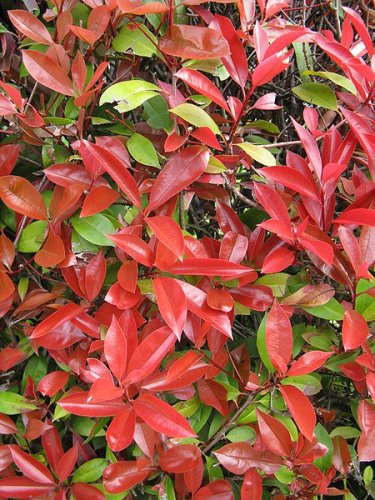 Photinia glabra
Photinia glabra
Author: KENPEI (Creative Commons Attribution-Share Alike 2.5 Generic)
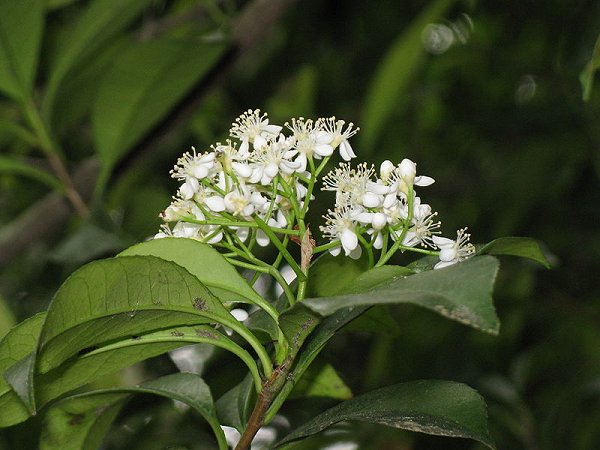 Photinia glabra
Photinia glabra
Author: KENPEI (Creative Commons Attribution-Share Alike 2.5 Generic)
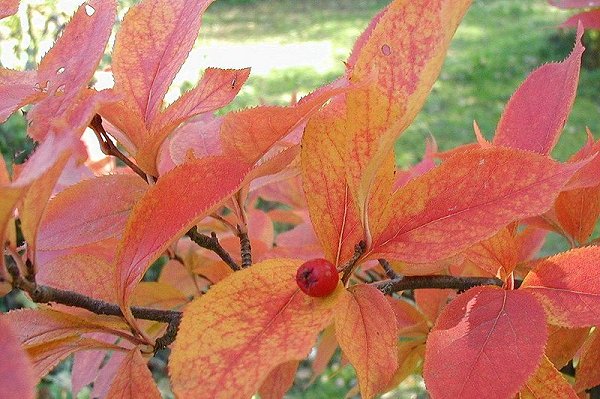 Photinia villosa
Photinia villosa
Author: Sten (Creative Commons Attribution-Share Alike 2.5 Generic)
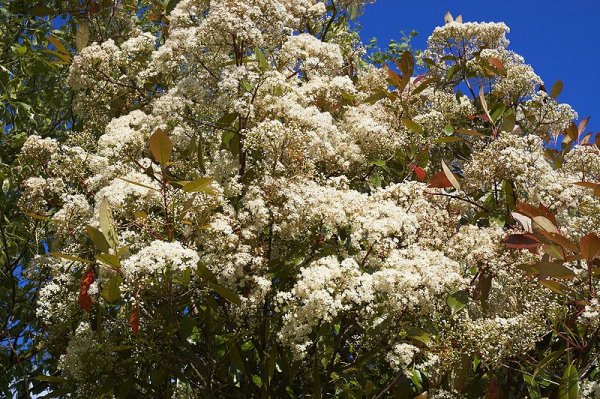 Photinia x fraseri
Photinia x fraseri
Author: Wouterhagens (public domain)
<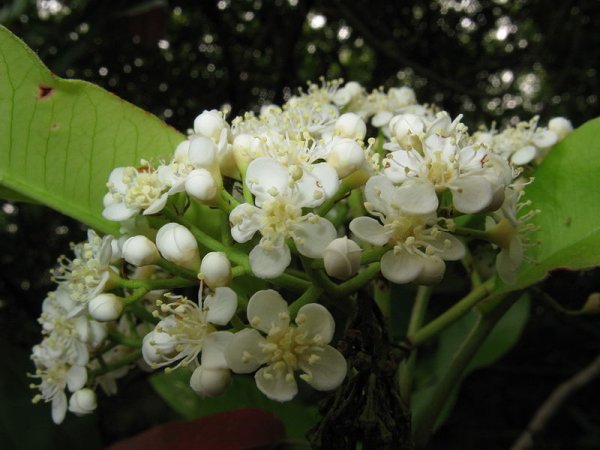 Photinia serratifolia
Photinia serratifolia
Author: KENPEI (Creative Commons Attribution-Share Alike 2.5 Generic)
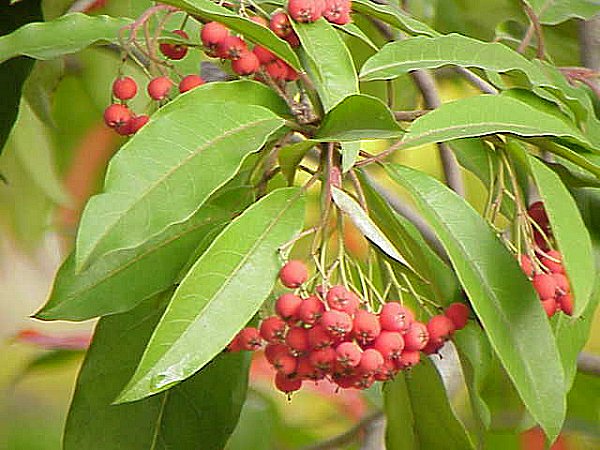 Photinia davidiana
Photinia davidiana
Author: Kurt Stueber (Creative Commons Attribution ShareAlike 3.0)
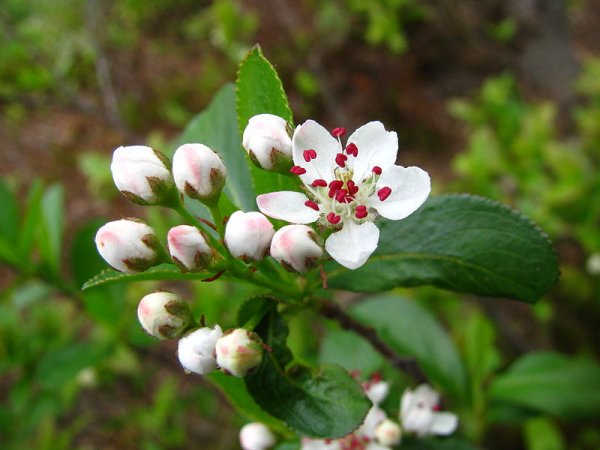 Photinia melanocarpa
Photinia melanocarpa
Author: Jomegat (Creative Commons Attribution ShareAlike 3.0-unported)
Both evergreen and deciduous Photinia species are grown for their colorful foliage. The young leaves of evergreen plants are usually in brilliant shades of red, while the foliage of deciduous plants often turns red in autumn. Photinia is a popular ornamental shrubs, grown for their fruit and foliage. It can grows to 3-15 m tall, with an irregular crown of angular branches which are often thorny. Its leaves are alternate, entire or finely toothed, 3-15 cm long and 1-5 cm wide. Flowers are produced in dense terminal corymbs in early summer. Each flower is a five rounded white petals of about 5-10 mm in diameter, with a mild scent. The fruit is a bright red, berry-like small pome of 4-12 mm across, maturing in autumn and often persisting well into the winter. The berry-like fruits are consumed by birds, such as thrushes, waxwings and starlings. The seeds are later dispersed in their droppings. Photinia species are used as food plants by larvae of some Lepidoptera species such as Feathered Thorn, Common Emerald and Setaceous Hebrew Character. Photinia is poisonous to grazing animals, although generally avoided due to the red color, cuttings mixed in with feed can caused adverse or deadly reactions.
Photinia x fraseri, 5 m high and across, is an evergreen hybrid. It has leathery dark green leaves which are red or bronze when they emerge, and clusters of white flowers are produced in mid- to late spring.
Photinia glabra, 3 m high and across, is an evergreen hybrid which has bright red young leaves and white flowers, followed by small red fruits.
The deciduous Photinia villosa, 5 m high and across, has dark green leaves, which turn red ans orange before they fall. Flowers are borne in late spring, followed by red fruits.
Photinia grows well in full sun or partial shade, in moisture-retentive but well-drained soil. Propagation is by seed in autumn; semi-ripe cuttings in summer. Diseases are mildew and fire blight (a contagious disease affecting Rosaceae family such as apples and pears; the affected areas appear blackened, shrunken and cracked, as though scorched by fire).
 Photinia glabra
Photinia glabraAuthor: KENPEI (Creative Commons Attribution-Share Alike 2.5 Generic)
 Photinia glabra
Photinia glabraAuthor: KENPEI (Creative Commons Attribution-Share Alike 2.5 Generic)
 Photinia villosa
Photinia villosaAuthor: Sten (Creative Commons Attribution-Share Alike 2.5 Generic)
 Photinia x fraseri
Photinia x fraseriAuthor: Wouterhagens (public domain)
<
 Photinia serratifolia
Photinia serratifoliaAuthor: KENPEI (Creative Commons Attribution-Share Alike 2.5 Generic)
 Photinia davidiana
Photinia davidianaAuthor: Kurt Stueber (Creative Commons Attribution ShareAlike 3.0)
 Photinia melanocarpa
Photinia melanocarpaAuthor: Jomegat (Creative Commons Attribution ShareAlike 3.0-unported)
 Index of 690
Plants in The Flowering Garden
Index of 690
Plants in The Flowering Garden
Copyright © 2008-2018 The Flowering Garden. All Rights Reserved.